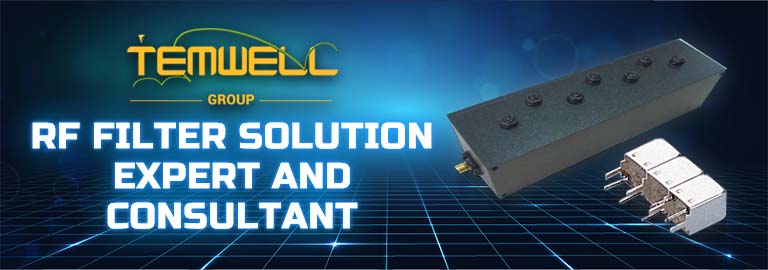RF filters are electronic components that are used to allow or prevent selected signals or frequencies in order to eliminate noise or pass through of unwanted signals. Common types are low pass filters, high pass filters, and bandpass filters.
In microwave communication systems, such as radars, test, and measurement systems, etc., microwave radio frequency filters are the key electronic components. The filter is a passive circuit, and after proper design and setting, it can produce microwave radio frequency filtering.
As mobile devices become more powerful and support more and more network frequency band, RF front-end modules have become an indispensable part of mobile devices. For example, a newer mobile phone needs to support at least 3G, 4G, 5G and WiFi, GPS, and other network standards, and each standard requires its RF front-end module. RF front-end modules generally include antenna switches, multiplexers, filters, power amplifiers, and low noise amplifiers, and so on.
Why Do We Need An RF Filter?
With the development of wireless communication applications, people have higher and higher requirements for data transmission speed. In the 2G era, only a small number of people will use their mobile phones to surf the Internet and browse the WAP version of the web, and the required data rate is about 1KB/s. In the 3G era, with the popularity of smartphones, the use of operators’ networks to send and receive emails, and the use of various apps have resulted in a dramatic increase in network traffic. The required data rate is about 50KB/s. In the 4G era, applications such as live broadcast have greatly increased the bandwidth requirements of mobile phone communications, and the required data rate has reached 1MB/s. Not to mention the 5G era that is entering, which requires faster and larger amounts of data transmission.
Corresponding to the increase in data rate is the high utilization of spectrum resources and the complexity of communication protocols. These two issues are complementary: Due to limited spectrum resources, to meet people's demand for data rates, the spectrum must be fully utilized. Therefore, a mobile phone must be able to cover a wide frequency range, so that different people's devices can be used in crowded situations. Only then can sufficient spectrum bandwidth be allocated. At the same time, to meet the data rate requirements, carrier aggregation technology has been used since 4G, so that a device can use different carrier frequency spectrums to transmit data at the same time.
On the other hand, to support a sufficient data transmission rate within a limited bandwidth, communication protocols have become more and more complex, so strict requirements have been put forward for various performances of the radio frequency system.
In the RF front-end module, the RF filter plays a vital role. It can filter out-of-band interference and noise to meet the signal-to-noise ratio requirements of radio frequency systems and communication protocols. As mentioned above, as the communication protocol becomes more and more complex, the demand for the communication protocol inside and outside the frequency band becomes higher and higher, which also makes the design of the filter more and more challenging. In addition, as the number of frequency bands that mobile phones need to support continues to increase since each frequency band needs to have its filter, the number of filters that need to be used in a mobile phone is also increasing.
Filter Technology
The most important indicators of radio frequency filters include quality factor Q and insertion loss. In the current communication protocol, the frequency difference between different frequency bands is getting smaller and smaller, so it needs very good selectivity to let the signals in the passband pass and block the signals outside the passband. The larger the Q, the narrower the passband bandwidth of the filter the better selectivity that can be achieved. In addition to the quality factor Q, insertion loss is also an important parameter. Insertion loss refers to the attenuation of the passband signal by the filter, that is, signal power loss.
At present, the most mainstream implementation methods of RF filters are SAW and BAW. SAW is a surface acoustic RF filter that uses the piezoelectric effect. When a voltage is applied to the crystal, the crystal will undergo mechanical deformation, converting electrical energy into mechanical energy. When this crystal is mechanically compressed or extended, the mechanical energy is converted into electrical energy. Charges are formed on both sides of the crystal structure, allowing current to flow through the terminals and/or forming a voltage between the terminals. In solid materials, alternating mechanical deformations can generate sound waves with a velocity of 3,000 to 12,000 meters per second. In the surface acoustic wave filter, the acoustic wave propagates on the surface and forms a standing wave, the quality factor of which can reach thousands.
Basic of RF filter types
A filter is a device that filters waves. It is a circuit that allows signals in a certain frequency band to pass while blocking signals outside the frequency band. Filters mainly include low-pass filters, high-pass filters, and band-pass filters, which can be divided into passive and active filters according to the working principle of the circuit.
-
Low pass filter:
Inductance prevents high-frequency signals from passing and allows low-frequency signals to pass, but the characteristics of capacitors are the opposite. A filter whose signal can pass through an inductor or a filter connected to the ground through a capacitor has less attenuation for low-frequency signals than high-frequency signals and is called a low pass filter. The principle of the low pass filters is very simple. It uses the principle that the capacitor passes the high frequency to block the low frequency, and the inductor passes the low frequency to block the high frequency. For the high frequency that needs to be cut off, use the capacitor to absorb the inductance and prevent it from passing; for the low frequency that needs to be released, low pass filter uses the characteristics of the high resistance of the capacitor and the low resistance of the inductance to let it pass.
-
High pass filter:
The characteristics of a high pass filters are generally expressed by a first-order linear differential equation. The left side of it is the same as the first-order low-pass filter. Only the right side is the derivative of the excitation source instead of the excitation source itself. When a lower frequency passes through the system, there is little or no output, and when a higher frequency passes through the system, there will be less attenuation. In fact, for extremely high frequencies, a capacitor is equivalent to a short circuit. These frequencies can be output at both ends of the resistor. In other words, high pass filter is suitable for passing high frequencies but has a greater obstructive effect on low frequencies, that is, the highest pass filter.
-
Bandpass filter:
The bandpass filter is a circuit that only allows specific frequencies to pass while effectively suppressing signals at other frequencies. Because of its selectivity to signals, band-pass is widely used in electronic design. For example, the RLC tank is an analog band-pass filter. A band-pass filter refers to a filter that can pass frequency components in a certain frequency range but attenuate frequency components in other ranges to an extremely low level, as opposed to the concept of a band-stop filter.
A new generation of substrate technology achieves 5G breakthroughs
The number of filters in the 4G era is about 60-80, and the number of filters in the 5G era will reach 120-150. Based on the POI optimized substrate, the new SAW filter can provide built-in temperature compensation and can integrate multiple filters on a single chip.
As one of the core components of the mobile communication system, the radio frequency filter is responsible for separating the radio signals transmitted and received by the mobile phone from different frequency bands. It is combined with the power amplifier (PA), Duplexer and Diplexer, Switch, and low noise amplifier (LNA). Together they form the radio frequency front end (RFFE) system. Due to the increasing complexity of 5G terminal design technology, radio frequency filter is estimated that the market’s compound annual growth rate (CAGR) within three years will be higher than 12%, reaching US$18 billion. At the end of 2019, the RFFE market was approximately US$13 billion (including 3G and 4G).
The supply of piezoelectric (POI) substrates for the new generation of 4G/5G ultra saw RF filters are essential to further enhance its advanced RF front-end product portfolio and the performance of 5G modems and RF systems. The technology is being integrated into multiple product lines, including the Power amplifier module (PAMiD), front-end module (FEMiD), diversity module (DRx), Wi-Fi splitter, GNSS splitter, and RF multiplexer. Considering that to achieve high-speed data transmission, 4G and 5G networks need to use more frequency bands. Therefore, smartphones must integrate a larger number of filters with better performance to ensure signal integrity and communication reliability.
The prospects of the filter market can be described as great, but the filter is still the most challenging module in the RF front-end.

Referral Link








.png)






